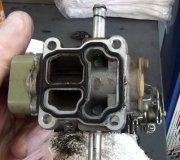What kind of help are you looking for?
A seized water pump is rare. Anything that causes the timing belt to jump more than three teeth will cause severe damage to the valves. The engine computer will shut the engine down if the timing belt jumps two teeth. That would normally happen long before the pump seized up tightly. If the repair didn't cost at least $1000.00, they didn't have to remove the cylnder head to repair the valves, so the water pump didn't actually seize up; it just was leaking or had sloppy bearings.
If the cylinder head was removed, there could be a leaking intake manifold gasket or a vacuum hose might have come loose. Those will cause the idle speed to fluctuate and be too high.
How did you determine the coolant wasn't circulating? Was the engine overheating? With all these problems, removing the thermostat just introduces another variable into the mix, and possibly new additional problems.
Locking brakes are probably not related to the water pump. Two common causes are brake fluid contaminated with petroleum product, and sticking caliper pistons. Fluid contamination will take up to a week or longer to show up. If a caliper is sticking, the brake pedal will feel normal. A less common cause is a constricted rubber brake hose. Rust builds up inside the crimp of the metal bracket attached to the center of the hose. In this case, the brake pedal will feel higher and more solid han normal. All you have to do is open the crimp on the hose bracket a little with a large pliers to solve this problem. As a test, park on a slight incline, put the car in neutral, then watch if it creeps ahead on its own when you release the brakes. If it doesn't, or if you can't push the car by hand on a level surface, try opening the two front bleeder screws. If you get a tiny spurt of trapped fluid from one of them and the car now moves freely, you found the one with a constricted hose.
Caradiodoc
Monday, February 8th, 2010 AT 9:31 PM


